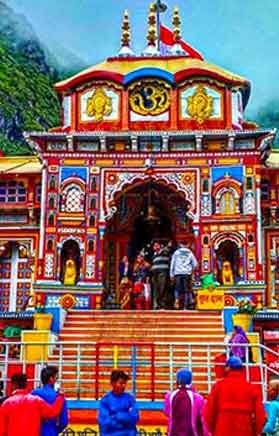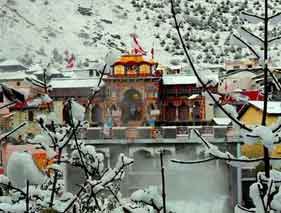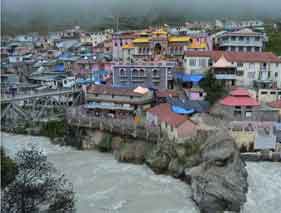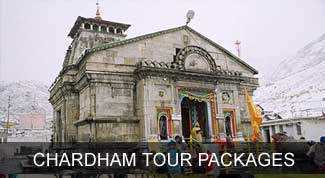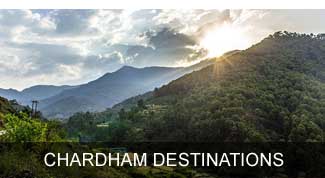Badrinath was re-established as a major pilgrimage site by Adi Guru Shankara in the Sixth century( as per the saying) , with an estimated and more than 6 Lakhs pilgrims visits every year and growing day by day.
Badrinath is also one of the four major shrines established by Adi Guri Shankaracharya ji called Puri / Rameshwaram / Dwarka and in the north Badrinath. Badri refers to a berry that was said to grow abundantly in the area, and nath means "Lord of". Badri is also the Sanskrit name.
The Badrinath temple is the main attraction in the town though there are more scared sites for the Hindu ritual in the life and after life. . According to legend there was some conflict with the Tibatian Buddhism and Hindu pilgrimage for Vaishnav sact.. Adi Guru Shankara discovered a black stone image of Lord Badrinarayan made of Saligram stone in the Alaknanda River. He originally enshrined it in a cave near the Tapt Kund hot springs. In the sixteenth century, the King of Garhwal moved the murti to the present temple.
In the 17th century, the temple was expanded by the kings of Garhwal. After significant damage in the great 1803 Himalayan earthquake, it was rebuilt by the King of Jaipur, The temple is approximately 15 m high with a small cupola on top, covered with a gold gilt roof as you may see on major temples in India. A large pillared hall that leads to the garbha grha, or main shrine area. The walls and pillars of the mandapa are covered with intricate carvings
As mentioned in the Mahabharata, when the Pandavas are said to have ended their life by ascending the garhwql Himalaya nd one of the a peak called Swargarohini - meaning , the 'Ascent to Heaven'. This is believed that eldest brother of Pandavas named Yudhister went heaven along with his Dog physically which is only one example in Hindu epic..
Badrinath one of the 'Four Dhams' is one of the most celebrated pilgrimage spots of the country and is situated at an elevation of 3,133 meters, guarded on either side by the two mountain ranges known as Nar & Narayan with the towering Neelkanth Peak providing a splendid backdrop. This revered spot was once carpeted with wild berries. Thus the place got the name "Badri van", meaning "forest of berries".
Best time to Visit Badrinath Dham
Badrinath has a chilly and cold climate almost throughout the year. The peak season to visit this place is between May to June and September to October. With the onset of the Monsoon season, Badrinath witnesses heavy rainfall and a drop in temperature. Winters here are extremely cold due to heavy snowfall. Mostly in winters, the temperatures touch the sub-zero level, making the climate too frosty. Hence the summer season is the ideal time to visit this place.
Summer :
In Badrinath, summers begin to set in from the Month of May and last till June. During this time, the climate here is moderately cold yet pleasing. In this season the temperature ranges between 7°C - 18°C. The days are pleasant while the nights are cold. Summer season is ideal for a spiritual visit to the Badrinath shrine and also apt for sightseeing trips.
Trip Essentials
Don't forget to pack light woollen clothing as Badrinath remains a lot cold even in the summers. Along with it, one must carry a list of essentials including a day pack, a pair of comfortable walking shoes/ trekking shoes, trekking pants, windproof jacket, sun cap, sunglasses, sunscreen lotion, lip balm, walking stick, personal toiletries and torch/ flashlight with extra batteries. One must carry a water bottle and some dry fruits, along with energy bars. To avoid dehydration, energy drinks like electoral (ORS)/ Gatorade are also vital to carry.
Monsoon :
Monsoons in Badrinath, begin from July and end in the month of September. This season experiences heavy rainfall with the temperatures dropping down till 15°C. The days are cold and the nights are chilly. Travelling can be a little difficult at this time as the frequent rains make this area prone to landslides. Apart from this one can still enjoy sightseeing and can also take pleasure in snow at higher altitudes.
Trip Essentials
Don't miss to carry a day pack with rain cover, a pair of trekking pants, waterproof hiking / trekking shoes, woollen clothing, thick fleece, windproof/ water resistant jacket, thick woollen socks, waterproof gloves, raincoat/ poncho, walking stick, personal toiletries and torch/ flashlight with extra batteries. One must carry a water bottle along with some dry fruits to munch on and energy drinks to avoid dehydration
Winter :
In Badrinath, October marks the beginning of the winter season which lasts till the month of April. The days in this season are frosty with average minimum temperature going down till 5°C. This is the time when Badrinath experiences heavy snowfall with temperatures touching the sub-zero level. At this time, the roads to Badrinath remain closed due to extreme weather conditions. Thus, it is not advisable to travel to this place during the winter season.
What to see in Badrinath Dham
Tapt Kund :Natural thermal springs on the bank of the river Alaknanda, where it is customary to bathe before entering the Badrinath temple.
Narad Kund : A recess in the river, near Tapt Kund, forming a pool from where the Badrinath idol was recovered.
Brahama Kapal :A flat platform on the bank of river Alaknanda. Hindus perform proppitiating rites for their deceased ancestors.
Sheshnetra :1.5kms. away is a boulder having an impression of the legendary serpent, better known as the Sheshnag's eye.
Charanpaduka :3kms. away is a beautiful meadow where the footprint of Lord Vishnu is seen on a boulder.
Mata Murty Temple :Devoted to the mother of Sri Badrinathji. Other important temples include Sesh Netra Temple, Urvashi Temple and Charanpaduka.
Mana Village : Inhabited by an Indo-Mongolian tribe, it is the last Indian village before Tibet.
Vasundhara :As the name suggests, vasundhara is a magnificent water fall. This place is 5 kms. from Badrinath out of which 2 kms. is motorable upto Mana.
Bhim Pul :On the other side of Mana village, a massive rock forming a natural bridge, lies over the roaring Saraswati river. It presents a spectacular view of water thundering down through the narrow passage under the rock and is believed to have been placed there by Bhim, the second eldest among the five Pandava brothers.
Vyas Gufa (cave) :Near Mana Village, this is a rock-cave where Ved Vyas is believed to have composed the Mahabharata and the pauranic commentaries.
How to reach Badrinath Dham
Route :Haridwar - Rishikesh - Deoprayag - Kirtinagar - Shrinagar - Rudraprayag - Gauchar - Karnaprayag - Nandprayag - Chamoli - Birahi - Pipalkoti - Garur Ganga - Helang - Joshimath - Vishnuprayag - Govindghat - Pandukeshwar - Hanumanchatti - Badrinath.
Air :Jolly Grant airport, Rishikesh Road, Dehradun, is the nearest airport to Gangotri. One can hire a cab or get a bus from here.
Rail :Regular trains to Haridwar and Dehradun are available at all times of the year. One can hire a cab or get a bus from here.
Road :Badrinath is well-connected with motorable roads from important destinations of Uttarakhand.
